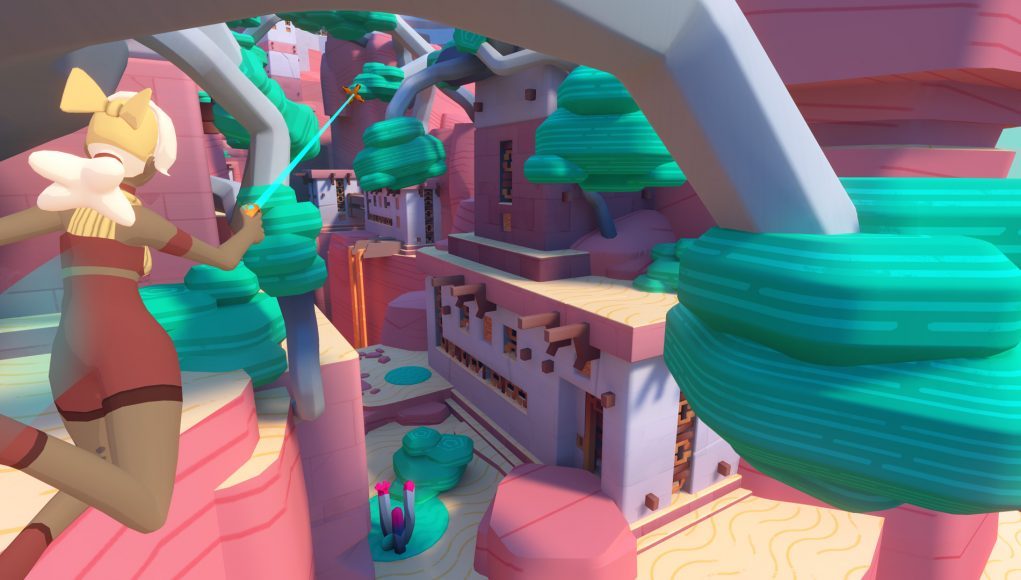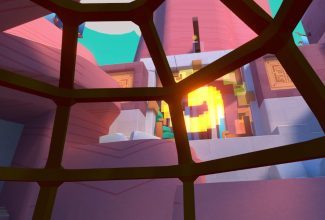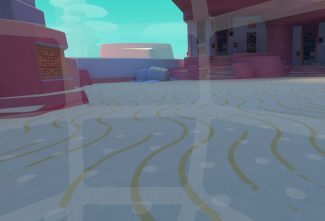As one of the first full-length games for VR, Windlands (2016) pioneered a movement scheme that sends you soaring high into the air, using your grappling hooks to swing from bush to tree in the desolate world that was fractured and destroyed after a planet shaking conflict. The latest Windlands isn’t simply a continuation of the hunt for all-important power crystals and Easter eggs though, now boasting enemies, multiplayer co-op, races, and a classic gaming-inspired story that confronts players with the disastrous forces that wrecked the once prosperous world; it feels like the true beginning of the series.
Windlands 2 Review Details:
Developer: Psytec Games
Available On: Oculus Store (Rift) – Coming to HTC Vive & PSVR
Reviewed On: Oculus Rift
Release Date: September, 12th 2018 (Rift), TBD (Vive & PSVR)
Gameplay
Windlands 2 is a first-person VR combat platformer that builds on the lore explored in the first; you don’t need to play the original Windlands to know what’s going on, because all of that’s largely fleshed out in the second installment anyway. The game introduces us to the history of the world and the reasons behind your quest. Here’s the short of it: long ago a dimension-jumping demon destroyed the lizard-people’s world with giant automatons, reducing the alien planet to a barren wasteland. He was slain by your golden-eyed human ancestor though, and generations later, you find yourself as an apprentice of a new class of humans, called ‘guardians’, that are capable of wielding impressive jumping and swinging abilities. You’re on a journey to an island with your master, Tohir, who starts—forgive the pun—showing you the ropes through the puzzle-like configuration of the world. There you battle the dark forces that rise again.
If you thought the addition of combat and NPCs was going to change the amount of platform-jumping and swinging madness seen in the first Windlands, you shouldn’t worry. There’s still plenty of that to go around as you gain one new ability not seen in the game’s pacifist forerunner: bow-shooting.
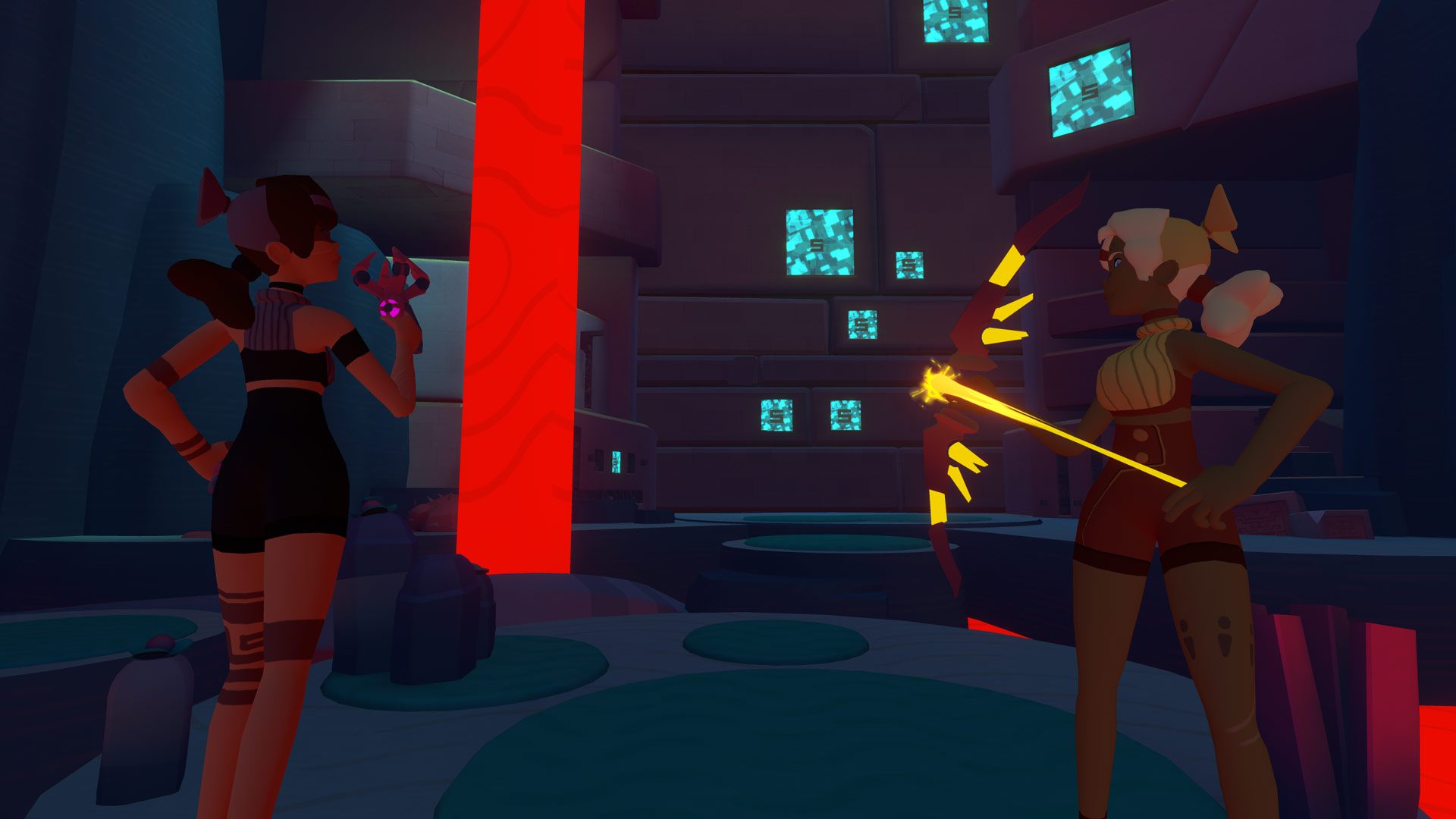
The new world of Windlands 2 delivers giant bosses, annoying laser-shooting droids, and a few timed shooting challenges to sharpen your new bow-handling ability. And you’ll need those shooting skills too, as bosses fire lasers, energy bombs, homing missiles, and spit out other droids to harass you. By the time you pass the half-way point in the game though, you don’t really see any new attack types, just a higher quantity.
Bow-shooting, while overall good, was at first a fiddly thing, and there’s a few things to know before heading it. There’s a reticle, but your infinite laser arrows have a definite arc affected by gravity, making it more of an indicator of whether you’ve lined up the shot correctly on the x-axis. Activating the bow is handled via Oculus Touch’s grip buttons, and can be deployed while using the grappling hooks, which are mapped to the triggers. Swinging and shooting at the same time, which becomes a necessity in some levels, isn’t as dead simple as I would have hoped, although it’s entirely possible once you get the hang of it. Set as default, the first grip button you activate deploys the bow, while the other hand (using grip) can draw arrows. About half the time I would instinctively activate both grip buttons for a quick shot, and would accidentally switch the bow to my non-dominant hand, something I think could be easily solved by simply checking a box at the beginning of the game. About half-way through, I dug into the advanced settings and found a selector that would allow me to lock the bow to my left hand, relieving the issue entirely. From thereon out, shooting became less and less of a hassle as I got the hang of it.
Unlike the first Windlands, there’s no central hub to return to. The world is a few disparate open areas with distinctive pathways that can take you in different directions, all of which is connected together by a couple of world portals that activate as the result of completing key missions in the storyline, letting you progress through the increasingly perilous biomes; jungle, desert, and mountain. By default, waypoint markers send you to your next objective, and plenty of checkpoint gates are littered along the way to make sure you’re not pulling your hair out at every massive fall. I have very little love for waypoints, but it’s easy to understand why Windlands 2 relies on these as a default to help you navigate through the divergent mass of spaghetti of the game’s map. If there weren’t enough challenges to worry about along the way, I might see it as an overall negative, but in the end it’s a necessary evil so you don’t go clambering up the wrong path and get completely lost. These can also be turned off entirely in the advanced settings.
The story itself is simple, and harks back to a time in classic gaming when quest-givers didn’t ask questions, but rather sent you, the silent protagonist, on your merry way to fetch something important: A to B. I found it a bit too simplistic personally, acting really more as an ends to means: fetch the thing, or kill the thing—so basically the early Zelda games. After a while the fetch quests start to feel a little contrived, and while it didn’t really ruin any of the jumping, swinging and shooting fun of the game, it didn’t really add anything either. It’s a classic story of an evil guy who does evil things because he’s evil, and everyone on your team is a helpful good guy because they’re helpful and good. I’ll soften that some in the Immersion section, because in the end, it’s a tried and true method of giving some structure to the real stars of the show, traversing the moving puzzle that is Windlands 2, and smacking down a few titanic bosses in the process.
That said, there is no leveling mechanic, and no new weapons or grappling hooks, which isn’t really a bad thing in my opinion. You’re simply left with the task of getting better at the game, and aren’t fed any cheaty tools to do so.
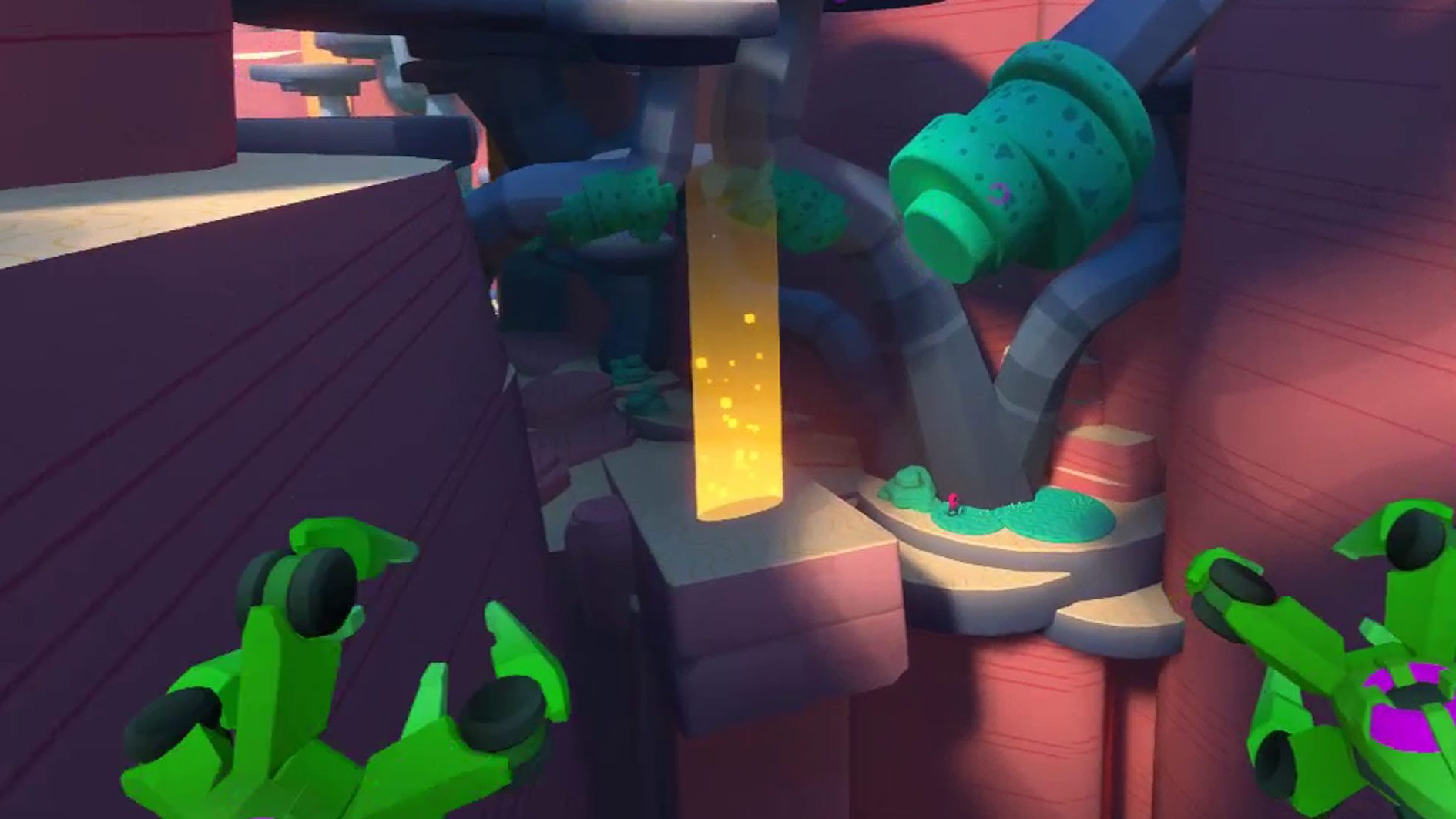
Except for the addition of a bow, the basic controls are virtually unchanged from the first Windlands. This may be a bit of a sticking point for some, since the game has a characteristic ‘floatiness’ that can be difficult to master. Landing those far parkour jumps isn’t easy, as you slide across most surfaces, and getting that double-hook swing and transitioning to a single hook whip around is even harder. Judging the distance of those far grappling hook grabs has to become something you intuit after a while.
Then, you can imagine the grappling hooks take a while to master. Both grappling hooks have a reticle that lights up when you come close enough to a leafy object—the only thing your hooks can grab onto in an inhospitable world of sand, rock, and streaming lava pools. I found that more often than not, the max effective range was actually a bit farther than the reticles would have you believe, making for daring saves that can mean the difference between having to repeat an extremely difficult jump and quickly making your way to the objective or level boss. Multitasking a few frantic arrow shots while flying through the air to your next landing point can be really satisfying, although hard depending on how comfortable you get with the movement scheme.
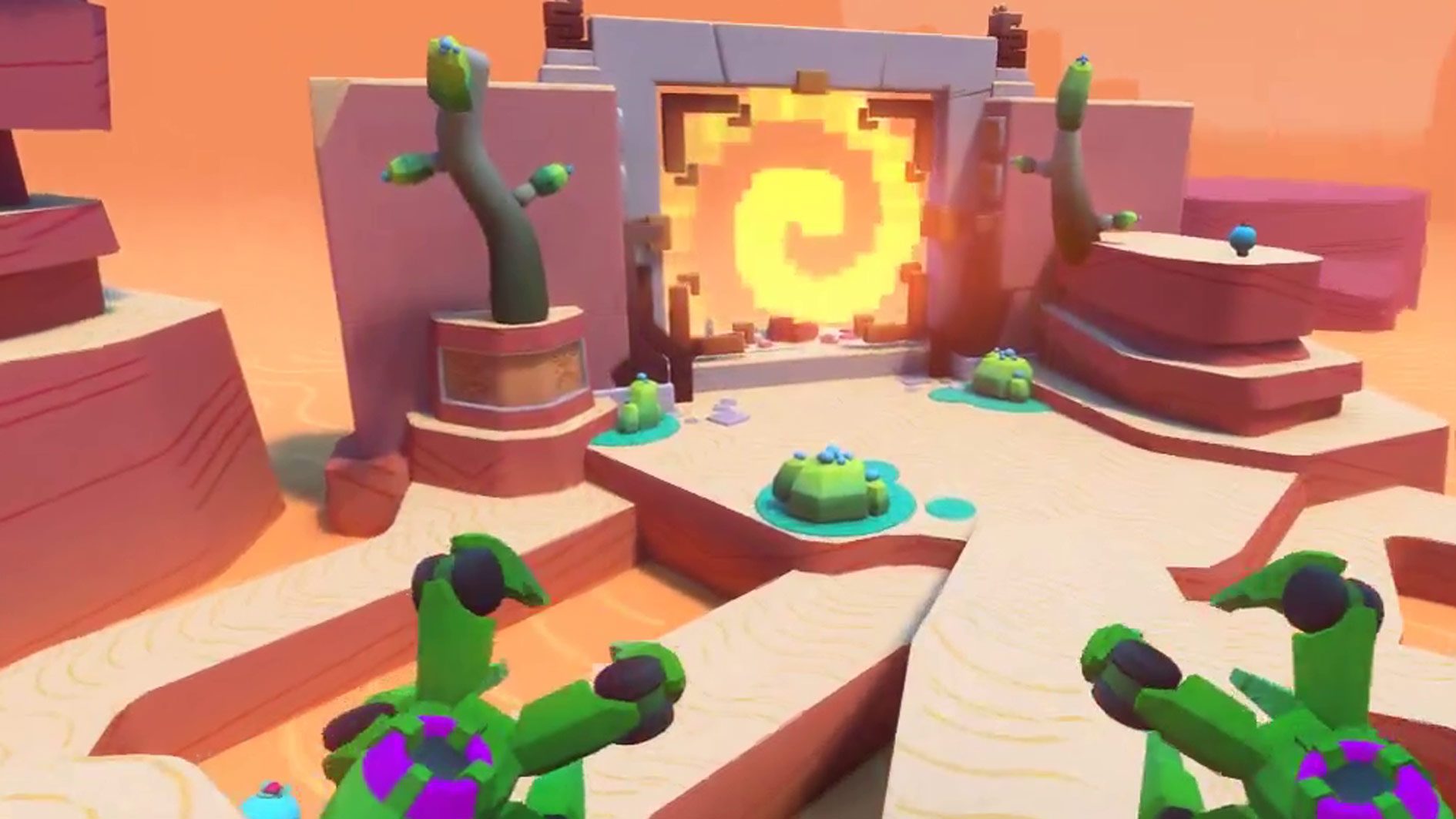
That brings me to difficulty. While there is an easy, medium, and hard mode, these only change how powerful an enemy’s shots are and how accurate they’ll be. On hard mode, you’re given only one direct hit before you’re tossed back to your last checkpoint. This doesn’t change the difficulty of the game’s platforming aspect though, which crescendos in the game’s third and final level. There, every jump has to be near perfect, which is equal parts frustrating and rewarding.
Since you can respawn at your last checkpint ad infinitum without any consequence, boss battles can turn into you slowly chipping away at them without fear of ever really losing anything. Playing through the game mostly alone, I found it took several deaths before I could figure out each bosses attack style, and started exploiting the area’s natural hiding places and angles of attack. Bosses follow a familiar pattern: beat them three times and they’re done. To beat a boss, you simply shoot out the glowing red armor on their bodies, which vary in position and number depending on the boss’ difficulty level. In between these moments, the area is usually filled with droids, which you have to destroy to carry on with the boss battle.
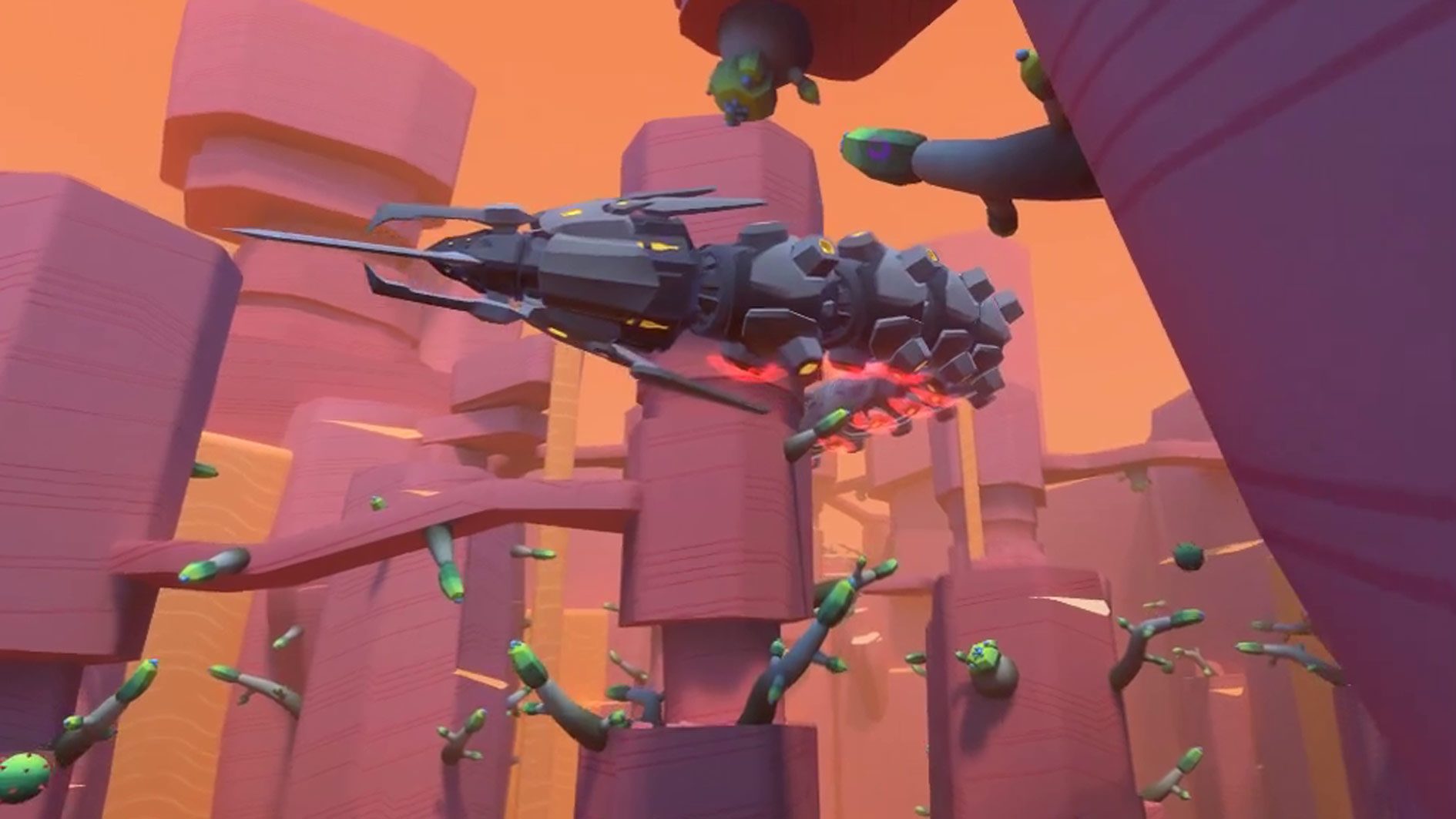
I would have liked to see more variability in this area, as after a while each enemy starts to feel more of less the same—still pretty exhilarating, but trending toward a standard interaction despite the physical differences of each boss. While the game’s ‘zero penalty’ death scheme mitigates some of the frustration of getting ganked—you pick up in real-time where you last died—this limits the ultimate reward felt after defeating them.
Here’s a quick one-minute clip of a boss battle in the desert world. Yes, I died around a dozen times to chip away at its armor.
Bosses are much more simple to take down with a few more friends on hand though, letting you team up with a max of three other people. Playing with Road to VR’s Ben Lang, who joined my game already in progress, we took down a massive flying ship in about half the time. Beyond making bosses easier to take down, the added ability of having a few friends or strangers in-game inevitably leads to sharing techniques, goading people to hurry up and make more impressive jumps, and talking crap to each other. Multiplayer isn’t required to beat the game, but it’s a really fun touch nonetheless.
Windlands 2 personally clocked in at six and a half hours total, playing only story mode in single-player. That said, you can spend a lot more time hunting hard-to-reach collectibles, or playing the other multiplayer ancillary games like racing on one of the five available tracks, or alternatively playing a ‘collect’ mode where you race to get all of the map’s collectibles and make it to the finish line before you three other competitors. These both were fun places to show off your skills once you’ve finished the game, but with so many multiplayer options available, it’s a danger that servers won’t be populated enough for quick pick-up games.
Immersion
The visual style, while patently low poly-ish, offers up a genuinely beautiful world. Taking a look back to the first Windlands, it’s clear the studio has refined the overall aesthetic to be more varied in both texture and architecture, but it still retains the charm of open vistas and precipitous areas to scramble up.
Character design is ostensibly inspired by Studio Ghibli films, although it features more of a Saturday morning cartoon-quality that you might see on Dragon Ball Z. There isn’t any interaction with NPCs outside of automatically handing over whatever you may have fetched, be it a robot part or a crystal to power a world portal. NPCs tend to gesticulate with their hands, but they never seem to open their mouths to talk. It’s not unnerving, but a bit strange just the same. They’re perfectly useful as quest-givers though, and are both extremely well voice-acted and realized from a design perspective.
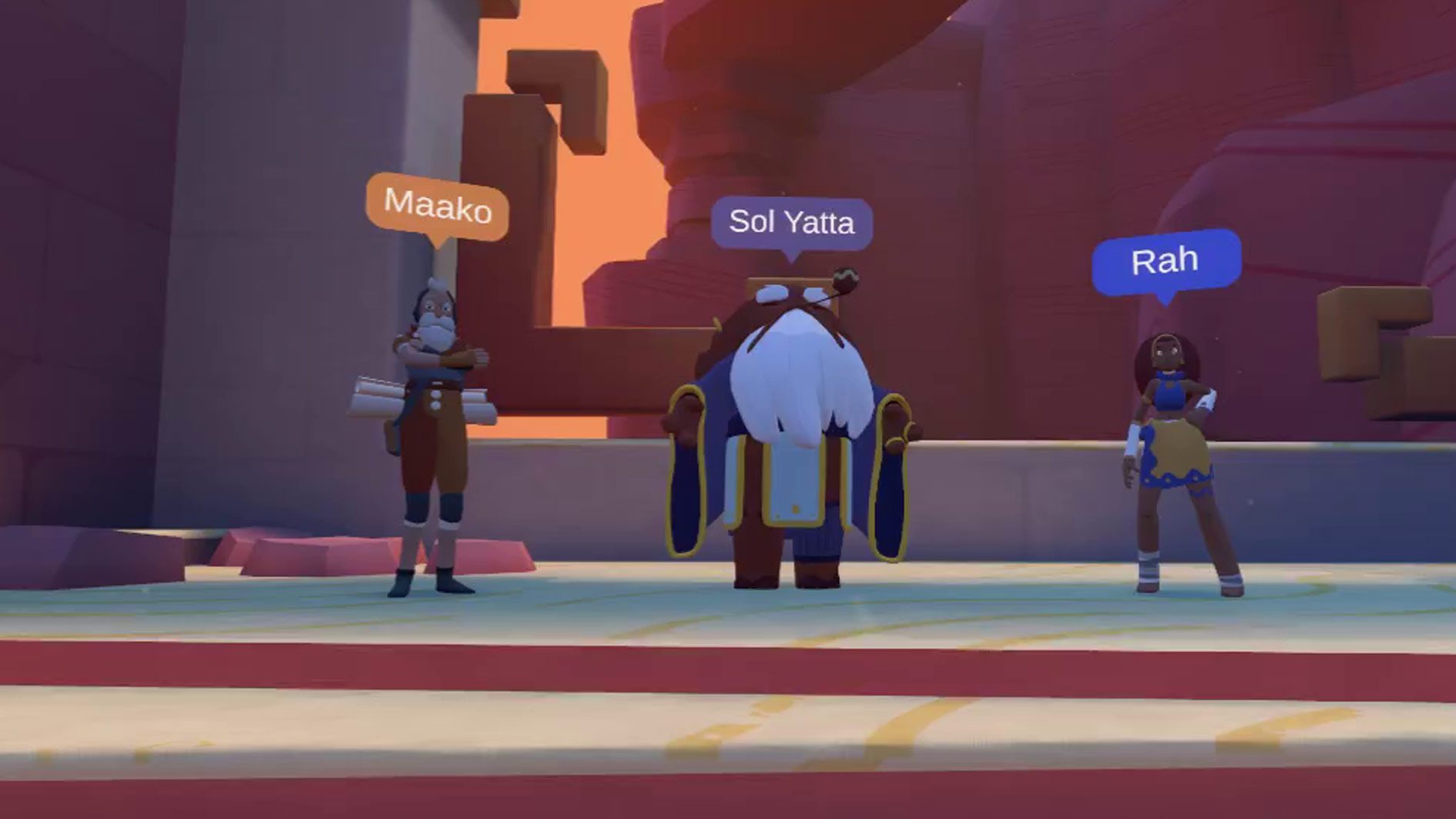
Positional audio is also extremely well done, with moments where a tinkling Easter egg collectible will drive you mad searching for it, or alternatively send you into a panic as a beeping homing missile closes in on your position.
As for object interaction, there’s no inventory to faff about with, or any objects to handle, so the meat of the game’s immersion plainly rests on the feelings of adrenaline and triumph of clattering up that difficult wall near a pool of insta-death lava, or swinging to that barely-reachable cactus.
Looking out over a steep drop doesn’t illicit the same pit in my stomach after a few minutes of playing as it once did, but I’ve also played through the first Windlands, so if it’s your first experience with the series, soaring through the air and hooking your way to the top is ultimately a really novel experience that just feels right.
Comfort
Windlands 2 has a buffet of comfort options, although since it’s a smooth-forward running and jumping game, it could be intense for newer VR users.
To mitigate this, the game features a few advanced options. There is a ‘comfort cage’, a literal cage around you, offered in both translucent and opaque varieties. Floor markers are also available, which give you a constant translucent floor area. There are vignettes (aka FOV-limiters), although I preferred not to use it to no obscure my peripheral vision for that next hook hold.
The game features seated and standing options, smooth turn or variable snap-turn, and hand-relative or head-relative forward motion. With all of these in place, most new users should be able to adapt to the game’s swinging locomotion scheme without too much issue.
Final Thoughts
In retrospect, I wasn’t sure whether I’d really like Psytec’s choice to flesh out the Windlands brand, changing it from the zen-like platformer to its now combat-focused co-op story. And while some of that story was less clever than I would have hoped for on first blush, it left me feeling like I had re-entered a classic game, where your goals are complicated, but your motivations to those goals aren’t. In a way, letting you tackle those barriers together as friends felt a bit like a group hiking trip.
In the end, I’m happy to see the original’s hard-won locomotion scheme, which was pretty experimental in the early DK2 days, make its way into something that most importantly hasn’t overextended itself too much into being the end-all, be-all. On an indie budget, biting off more than you can chew usually backfires, as promises go half-completed, and the player is left wondering what the hype is about. Blemishes and all though, I’m ready to play more.

